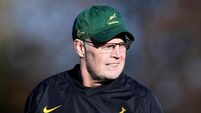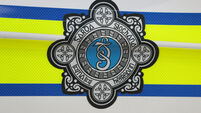Larry Ryan: Uneasy ceasefire in hurling’s culture war

SYMBOL OF THE AGE: View of tactics board at Parnell Park in Dublin. Photo by Piaras Ó Mídheach/Sportsfile
“Kilkenny could have Cillian Buckley playing as a quasi,” reckoned Dalo on the podcast the other week.
That is where we are now in hurling’s tactical evolution, that complex positional manoeuvres are being casually described in vague shorthand. As if Paul Merson was decoding Pep.
A lot has happened in a decade.
At the height of the Kilkenny-Tipp trilogy at the turn of the noughties, tactics were the stuff of deathbed confession. Yes Father, those are Celtic Crosses on the mantelpiece alright but, God forgive me, it’s time I got it off my chest; we used tactics.
In the aftermath of Tipp’s 2010 breakthrough, Ger Loughnane in punditry was quick to renounce any contamination: “Tipp dug out their victory, not through tactics, but good old-fashioned guts, determination and genuine players giving everything they had and putting it all on the line for the cause of Tipperary.”
Others at the time simply referred to the cowardly act of tricking around with your formation as “that oul bollixing”.
It was the era of 15 on 15, man to man, win your own ball.
Sure, there was folklore. Tales of the Third Midfielder should probably have been an staple, alongside Miss Flanagan.
Dalo protests to this day that he didn’t really make Alan Markham the first sweeper in 2004.
“There have been tactics,” whispered Galway’s David Burke at one stage. “Cyril Farrell has come out there talking about tactics in the 1980s.”
As if Cyril had been Vincent Hanley going out to America to send back rock videos.
But by then Cyril had largely repented, as such. And preferred to boil things down to wristiness. To hip and whip.
As time passed, and Kilkenny reclaimed the perch, there were wicked allegations that they were secretly using performance-enhancing tactics. But nothing could be proved. If lads instinctively dropped back the field a small bit to ‘protect’, could it really be pinned on the boss?
Cody’s hands were vigorously rubbed clean.
Fast-forward and John Kiely is Cody’s natural successor as hurling’s plain speaker. A now serial winner, a no-nonsense figurehead who will give it to you straight, who spends all his time demanding hard work and honesty.
And he is held in high regard of course. Yet the hurling world is even more fascinated by Kiely’s right-hand man. It reveres this studious chap, who wouldn’t dream of sticking a knife in a football. He has been given the full Cody mononymous treatment.
Kinnerk. What will he come up with next, in his big brain? What ‘wildcard’? He is admired for responding swiftly to any problem set. Carol Vorderman in a polo shirt.
To some extent, hurling has fallen in love with the tactic. Schemes are being exchanged in hurling circles like tips for Fairyhouse. There are junior B teams ‘withdrawing past the forty’. Allowing the short puckout to the defender ‘least comfortable on the ball’ and being spoiled for choice.
Everyone has had to get on board. Might this even be the championship where Cody will say the words ‘false 11’?
So how has it come to this?
Like with everything, the pandemic played its part. Hurling without crowds was a more sterile, more intellectual experience. It was easier notice the intricacies when you weren’t swept along in the battle.
And then, courtesy of the water break, appeared the symbol of this new age. An apparition that empowered so many repressed tacticians to finally express the love that had dared not speak its name. There it was, out on the field in plain sight: a tactics board.
But before we got here there had been a rumbling culture war.
On one side there were the massed ranks of traditionalists. These lads weren’t savages. They were up to speed with all the modern advances in S&C and nutrition and maybe even a bit of psychology. They would openly encourage a wing back, if he was able, to put a message on a ball, rather than just ‘letting it in’. They wouldn’t even object to the odd short puckout, in moderation, to keep the other crowd guessing.
But they had certain red line issues, chief among them sweepers.
On the other side were the tacticians, the meddlers, with their supporting the ball carrier and their holistic approaches and their poster boy, the sweeper. As far as the traditionalists were concerned, that bate Banagher.
Friction between the forces bubbled under hurling’s surface, occasionally flaring up when some team stayed playing with four forwards when they were losing by eight points.
But gradual erosion of old certainties was evident. Bit by bit it became accepted that we would inevitably encounter tactics ruining our Sundays and matches involving the tacticians were wearily previewed as ‘likely to be a bit of a chess match’.
And occasionally the establishment forgot itself, especially if the right team won. “What Cody did tactically was just unbelievable,” Loughnane said after Kilkenny beat Waterford in 2016.
Tactics were becoming embedded. Yet there was still one final battle, on the weekend of the 2019 All-Ireland semi-finals.
Davy Fitz, a card-carrying tactician, had been beaten but comrades weren’t going to leave their man on the battlefield.
It was the night Derek McGrath figured third level education was doing wonders for hurling, incidentally a diametrically opposed view to John Giles’ take on how it has hampered our ability to produce good soccer players.
And it was also the night Dónal Óg Cusack suggested detractors of tactics were the last remnants of John Bull British culture in Ireland.
The fallout was ugly from that one. Yet three years on, division has all but melted away.
Language has softened. Instead of withdrawing, we are filtering back. Sweepers have been replaced by the plus one. Or maybe just ‘bodies’.
Or as TJ Ryan asked on Dalo’s live show in Limerick this week, “what’s the difference between a deep-lying centre back and a sweeper.”
Hurling people are largely getting along, playing it through the lines, but are they truly happy?
There’s still a certain ennui, a pining for less structured times. A sense we’ll one day be looking back with some distaste at this yellow balls era.
It would be fascinating if a stranger to hurling who’d been at any of the Tipp-Kilkenny trilogy had made their next visit for this spring’s league meeting of the teams.
Would they recognise the toddler turned teenager? They’d probably put the changes down to health and safety.
The crowd largely watched the tiki-taka hurling in a low torpor until early in the second half when a giant was released who didn’t really look like a man who’d seen the plan.
But he was fielding and bumping and bursting and marauding and whipping up a bit of a battle all around him and gradually people forgot themselves and became swept away.
Another man who has become known only by one name.
Walter.









